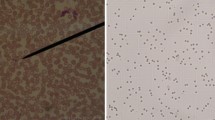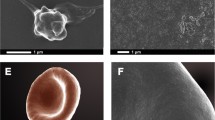Abstract
Brazil has the greatest diversity of snakes in the world and a large portion of them are venomous. Nowadays, Instituto Butantan (research center, at Brazil) produces various types of antivenom to meet the large number of incidences. In this investigation, mice were immunized with different species of Bothrops snake venom to evaluate the inorganic elements concentration in their blood by using NAA and XRF techniques. The results were compared with the control group (mice not immunized) and with human estimative. The data allows to evaluate the toxicity of these elements, important for clinical screening of patients submitted to immunological therapy.



Similar content being viewed by others
References
MINISTÉRIO DA SAÚDE (2001) Manual de diagnóstico e tratamento de acidentes por animais peçonhentos, 2a ed. Fundação Nacional de Saúde, Brasília
Jiménez-Porras JM (1970) Biochemistry of snake venoms. Clin Toxicol 3(3):389–431
Global Resource for Advancing Cancer Education (2015).http://cancergrace.org/cancer-101/2009/12/22/cancer-and-clotting-protecht. Accessed 05 Feb 2015
Rosa RR, Vieira EG, Villarroel MS, Siracura YQ, Iizuka H (1981) Análise comparativa entre os diferentes esquemas de imunização empregados na produção de soros antiofídicos pelo Instituto Butantan. Memórias do Instituto Butantan 45:259–270
SINAN/SVS/MS (2015) Boletim Epidemiológico Eletrônico, Junho 2009. http://sinan.saude.gov.br/. Accessed 12 April 2015
Butantan Institute (2015). http://www.butantan.gov.br/Paginas/default.aspx. Accessed 05 Feb 2015
Furtado MFD, Cardoso ST, Soares OE, Pereira AP, Fernandes DS, Tambourgi DV, Sant’Anna OA (2010) Antigenic cross-reactivity and immunogenicity of Bothrops venoms from snakes of the Amazon region. Toxicon 55:881–887
Zamboni CB, Metairon S, Suzuki MF, Furtado MF, Sant’Anna OA, Tambourgi DV (2009) Quantitative evaluation of blood elements by neutron activation analysis in mice immunized with Bothrops snake venoms. J Radioanal Nucl Chem 282:37–39
Baptista TS, Zamboni CB, Medeiros JAG, Freitas MG, Marcelino JR (2009) Blood evaluation of Cl and Na concentration in crioulo breed horses using NAA: comparison with human levels. AIP Conf Proc 1139:160–161
Baptista TS, Zamboni CB, Kovacs L, Freitas MG, Marcelino JR (2010) Blood levels of zinc in creole horses used in sera production. AIP Conf Proc 1265:407–410
Baptista TS, Zamboni CB, Marcelino JR (2011) Analysis of Cl and Na hyper immune sera by NAA. AIP Conf Proc 1351:332–335
Baptista TS, Redígolo MM, Zamboni CB, Sato IM, Marcelino JR (2012) Comparative study of inorganic elements determination in whole blood from Crioula breed horse by EDXRF and NAA analytical techniques. J Radioanal Nucl Chem 291:399–403
Sant’Anna OA, Mouton D, Ibanez OM, Bouthillier Y, Mevel JC, Reis MH, Biozzi G (1985) Basal immunoglobulin serum concentration and isotype distribution in relation the polygenic control of antibody responsiveness in mice. Immunogenetics 22:131–139
Wolfgang W, Salomão MG, Quijada-Mascareñas JA, Thorpe RS (2002) Biology of the Vipers. Origin and evolution of the South American pit viper fauna: evidence from mitochondrial DNA sequence analysis. Eagle Mountain Publishing, Eagle Mountain, pp 111–128
Medeiros JAG, Zamboni CB, Zahn GS (2006) Software para realização de análises hematológicas utilizando processo radioanalítico. In: Conference proceedings of 39º Brazilian Congress of Clinical Pathology/Medicine Laboratorial CD ROM
Ressler T (1998) WinXAS: a program for X-ray absorption spectroscopy data analysis under MS-Windows. J Synchrotron Radiat 5:118–122
Oliveira LC, Zamboni CB, Mesa J (2006) Quantitative estimation of Br, Cl, K and Na in sample blood by NAA. J Radioanal Nucl Chem 269:541–545
Zamboni CB, Oliveira LC, Kovacs L, Metairon S (2012) Ca and Mg determination from inhabitants of Brazil using neutron activation analysis. J Radioanal Nucl Chem 291:389–393
Zamboni CB, Metairon S, Rizzutto MA, Bernades S (2014) The use of portable X-Ray fluorescence spectrometry (PXRFS) for clinical practices. Conf Proc X LASNPA 1:1–6
Oliveira LC, Zamboni CB (2013) Sulfur determination in blood from inhabitants of Brazil using neutron activation analysis. AIP Conf Proc 1529:73–75
Ingenbleek Y, Kimura H (2013) Nutritional essentiality of sulfur in health and disease. Nutr Rev 71(7):413–432
Acknowledgments
We would like to acknowledge for financial support of the Conselho Nacional de Desenvolvimento Científico e Tecnológico (CNPq) and the Fundação de Amparo a Pesquisa do Estado de São Paulo (FAPESP).
Author information
Authors and Affiliations
Corresponding author
Rights and permissions
About this article
Cite this article
Metairon, S., Zamboni, C.B., Suzuki, M.F. et al. Inorganic elements in blood of mice immunized with snake venom using NAA and XRF techniques. J Radioanal Nucl Chem 309, 59–64 (2016). https://doi.org/10.1007/s10967-016-4770-0
Received:
Published:
Issue Date:
DOI: https://doi.org/10.1007/s10967-016-4770-0




